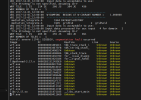susunyaner
New member
As I was using WRF-Solar shcu_physics=5 (Deng) to simulate the shortwave radiation conditions over China, I encountered a "segmentation fault".
The main physics settings for the simulation were as follows. When I change the shcu_physics to 2 (Park and Bretherton) or 3 (GRIMS), the simulation runs properly. I know that the Deng shallow cumulus has a high performance thus I want use it in the simulation.
Can you give me some advice about this? The complete namelist input are attached.
&physics
mp_physics = 8, 8,
ra_lw_physics = 4, 4,
ra_sw_physics = 4, 4,
radt = 5,
swint_opt = 2,
aer_opt = 1,
sf_sfclay_physics = 1, 1,
sf_surface_physics = 2, 2,
sf_urban_physics = 0, 0,
num_soil_layers = 4,
num_land_cat = 21,
bl_pbl_physics = 5, 5,
bldt = 0,
bl_mynn_tkebudget = 1, 1,
bl_mynn_tkeadvect = .true.,
bl_mynn_edmf = 0, 0,
cu_physics = 0, 0,
cudt = 0,
cu_rad_feedback = .false.,
shcu_physics = 5, 5,
isfflx = 1,
ifsnow = 1,
icloud = 1,
icloud_bl = 0,
num_land_cat = 21,
usemonalb = .true.,
sst_update = 1,
/
The main physics settings for the simulation were as follows. When I change the shcu_physics to 2 (Park and Bretherton) or 3 (GRIMS), the simulation runs properly. I know that the Deng shallow cumulus has a high performance thus I want use it in the simulation.
Can you give me some advice about this? The complete namelist input are attached.
&physics
mp_physics = 8, 8,
ra_lw_physics = 4, 4,
ra_sw_physics = 4, 4,
radt = 5,
swint_opt = 2,
aer_opt = 1,
sf_sfclay_physics = 1, 1,
sf_surface_physics = 2, 2,
sf_urban_physics = 0, 0,
num_soil_layers = 4,
num_land_cat = 21,
bl_pbl_physics = 5, 5,
bldt = 0,
bl_mynn_tkebudget = 1, 1,
bl_mynn_tkeadvect = .true.,
bl_mynn_edmf = 0, 0,
cu_physics = 0, 0,
cudt = 0,
cu_rad_feedback = .false.,
shcu_physics = 5, 5,
isfflx = 1,
ifsnow = 1,
icloud = 1,
icloud_bl = 0,
num_land_cat = 21,
usemonalb = .true.,
sst_update = 1,
/

